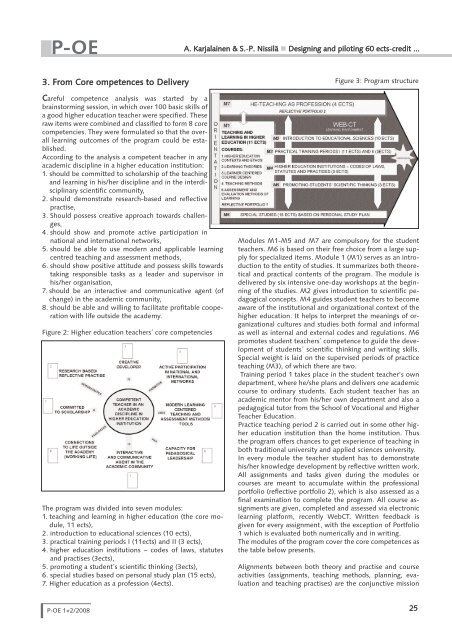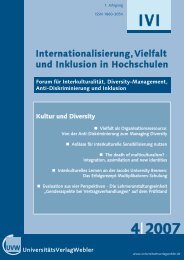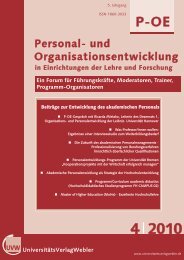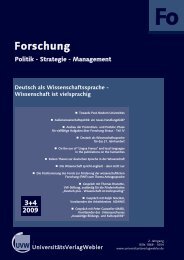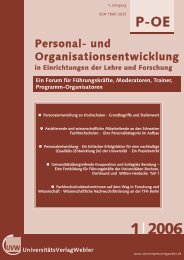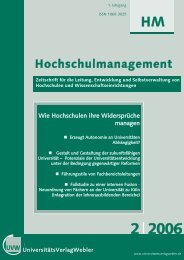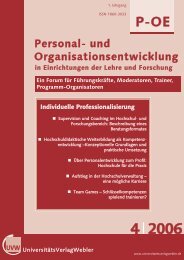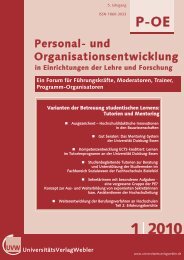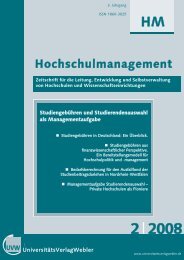P-OE - UniversitätsVerlagWebler
P-OE - UniversitätsVerlagWebler
P-OE - UniversitätsVerlagWebler
Sie wollen auch ein ePaper? Erhöhen Sie die Reichweite Ihrer Titel.
YUMPU macht aus Druck-PDFs automatisch weboptimierte ePaper, die Google liebt.
P-<strong>OE</strong><br />
A. Karjalainen & S.-P. Nissilä • Designing and piloting 60 ects-credit ...<br />
3. From Core ompetences to Delivery<br />
Careful competence analysis was started by a<br />
brainstorming session, in which over 100 basic skills of<br />
a good higher education teacher were specified. These<br />
raw items were combined and classified to form 8 core<br />
competencies. They were formulated so that the overall<br />
learning outcomes of the program could be established.<br />
According to the analysis a competent teacher in any<br />
academic discipline in a higher education institution:<br />
1. should be committed to scholarship of the teaching<br />
and learning in his/her discipline and in the interdisciplinary<br />
scientific community,<br />
2. should demonstrate research-based and reflective<br />
practise,<br />
3. Should possess creative approach towards challenges,<br />
4. should show and promote active participation in<br />
national and international networks,<br />
5. should be able to use modern and applicable learning<br />
centred teaching and assessment methods,<br />
6. should show positive attitude and possess skills towards<br />
taking responsible tasks as a leader and supervisor in<br />
his/her organisation,<br />
7. should be an interactive and communicative agent (of<br />
change) in the academic community,<br />
8. should be able and willing to facilitate profitable cooperation<br />
with life outside the academy.<br />
Figure 2: Higher education teachers´ core competencies<br />
The program was divided into seven modules:<br />
1. teaching and learning in higher education (the core module,<br />
11 ects),<br />
2. introduction to educational sciences (10 ects),<br />
3. practical training periods I (11ects) and II (3 ects),<br />
4. higher education institutions – codes of laws, statutes<br />
and practises (3ects),<br />
5. promoting a student´s scientific thinking (3ects),<br />
6. special studies based on personal study plan (15 ects),<br />
7. Higher education as a profession (4ects).<br />
Figure 3: Program structure<br />
Modules M1-M5 and M7 are compulsory for the student<br />
teachers. M6 is based on their free choice from a large supply<br />
for specialized items. Module 1 (M1) serves as an introduction<br />
to the entity of studies. It summarizes both theoretical<br />
and practical contents of the program. The module is<br />
delivered by six intensive one-day workshops at the beginning<br />
of the studies. M2 gives introduction to scientific pedagogical<br />
concepts. M4 guides student teachers to become<br />
aware of the institutional and organizational context of the<br />
higher education. It helps to interpret the meanings of organizational<br />
cultures and studies both formal and informal<br />
as well as internal and external codes and regulations. M6<br />
promotes student teachers´ competence to guide the development<br />
of students´ scientific thinking and writing skills.<br />
Special weight is laid on the supervised periods of practice<br />
teaching (M3), of which there are two.<br />
Training period 1 takes place in the student teacher’s own<br />
department, where he/she plans and delivers one academic<br />
course to ordinary students. Each student teacher has an<br />
academic mentor from his/her own department and also a<br />
pedagogical tutor from the School of Vocational and Higher<br />
Teacher Education.<br />
Practice teaching period 2 is carried out in some other higher<br />
education institution than the home institution. Thus<br />
the program offers chances to get experience of teaching in<br />
both traditional university and applied sciences university.<br />
In every module the teacher student has to demonstrate<br />
his/her knowledge development by reflective written work.<br />
All assignments and tasks given during the modules or<br />
courses are meant to accumulate within the professional<br />
portfolio (reflective portfolio 2), which is also assessed as a<br />
final examination to complete the program. All course assignments<br />
are given, completed and assessed via electronic<br />
learning platform, recently WebCT. Written feedback is<br />
given for every assignment, with the exception of Portfolio<br />
1 which is evaluated both numerically and in writing.<br />
The modules of the program cover the core competences as<br />
the table below presents.<br />
Alignments between both theory and practise and course<br />
activities (assignments, teaching methods, planning, evaluation<br />
and teaching practises) are the conjunctive mission<br />
P-<strong>OE</strong> 1+2/2008 25


